PESTLE Analysis and Business Environment Reform
VerifiedAdded on 2020/10/05
|15
|4757
|179
AI Summary
The assignment focuses on the concept of PESTLE analysis, which is a framework used to identify and evaluate macro environmental factors that affect businesses. It involves analyzing political, economic, socio-cultural, technological, legal, and environmental factors that impact an organization's operations. The document also discusses the business environment reform facility and its importance in supporting organizational growth and sustainability. By considering internal strengths and weaknesses alongside external factors, organizations can better navigate and adapt to changes in their environment.
Contribute Materials
Your contribution can guide someone’s learning journey. Share your
documents today.
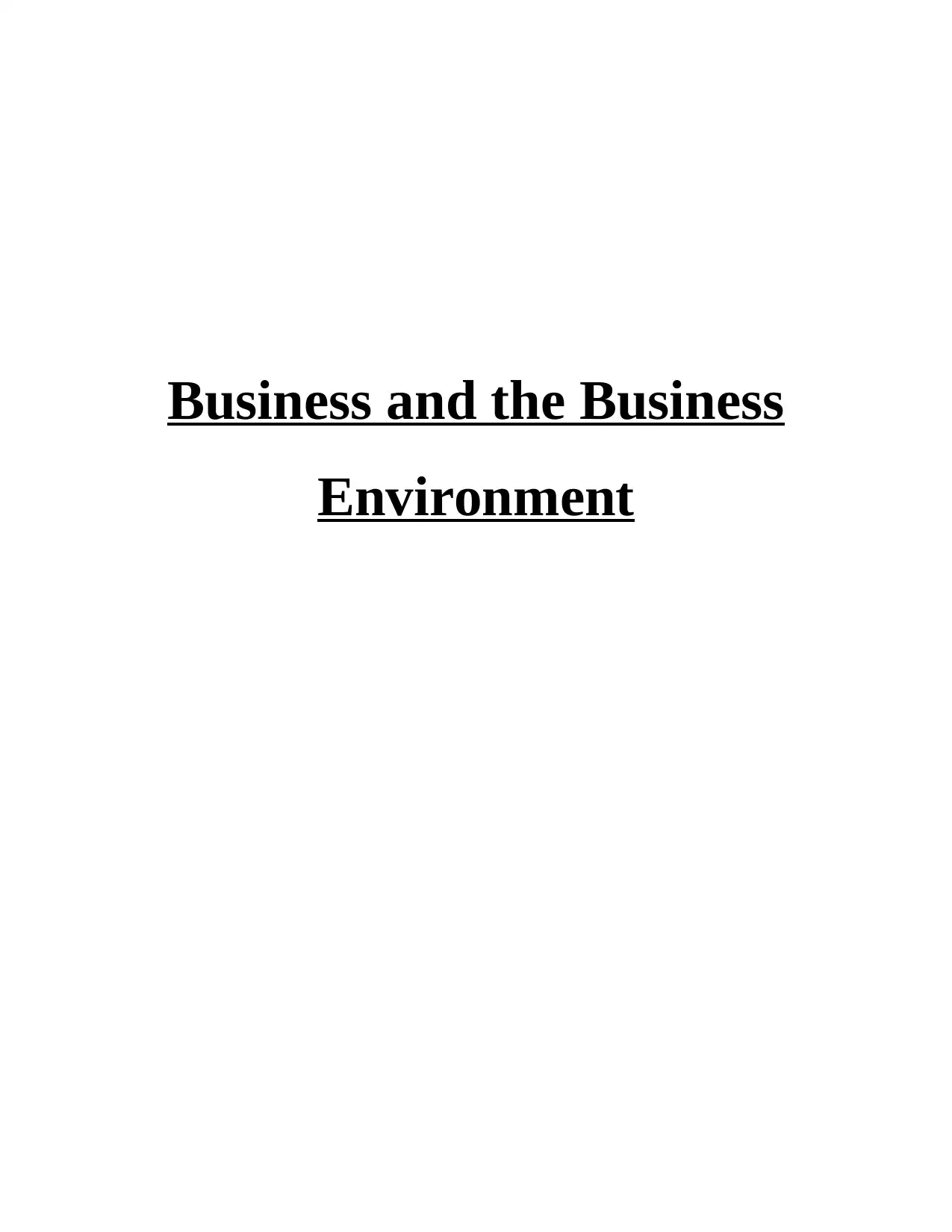
Business and the Business
Environment
Environment
Secure Best Marks with AI Grader
Need help grading? Try our AI Grader for instant feedback on your assignments.
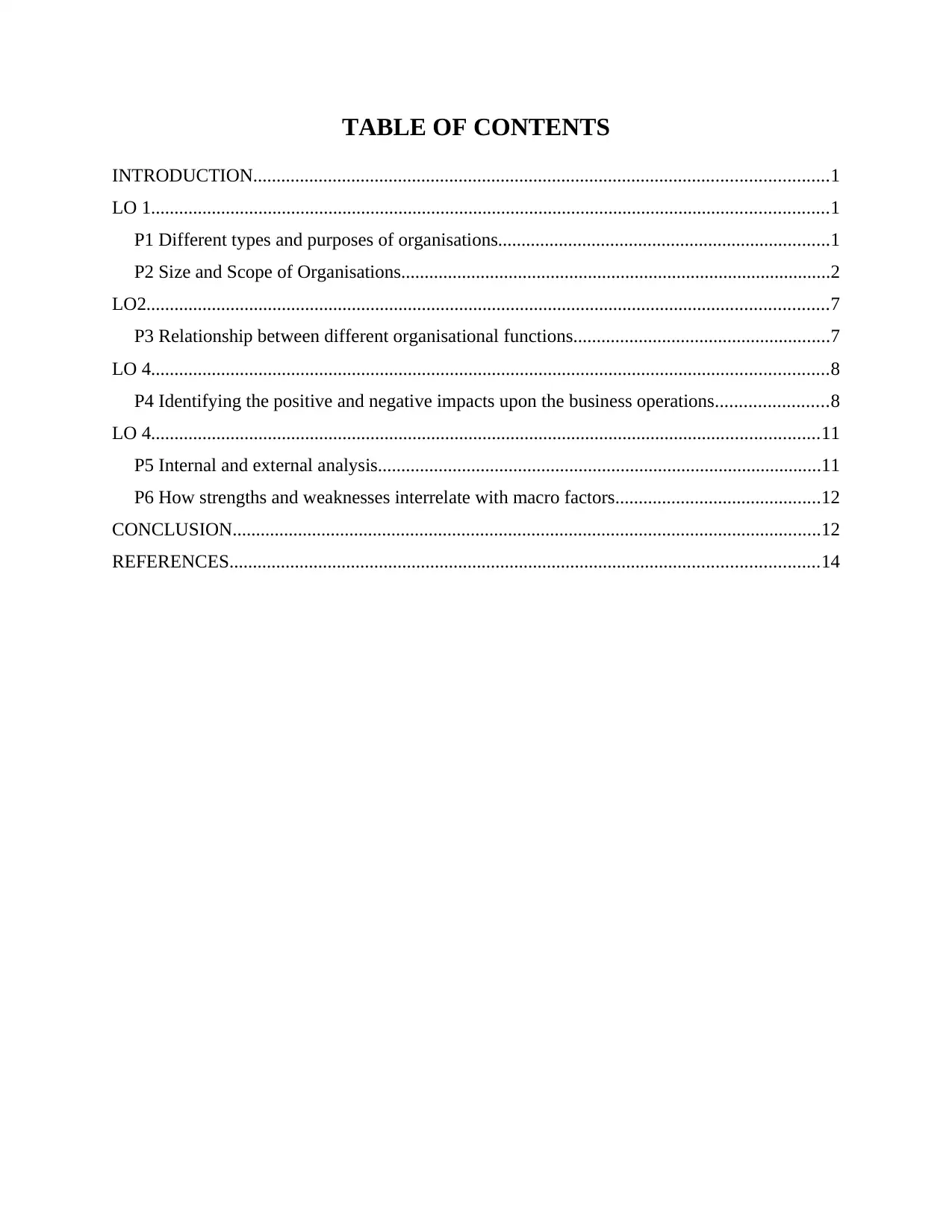
TABLE OF CONTENTS
INTRODUCTION...........................................................................................................................1
LO 1.................................................................................................................................................1
P1 Different types and purposes of organisations.......................................................................1
P2 Size and Scope of Organisations............................................................................................2
LO2..................................................................................................................................................7
P3 Relationship between different organisational functions.......................................................7
LO 4.................................................................................................................................................8
P4 Identifying the positive and negative impacts upon the business operations........................8
LO 4...............................................................................................................................................11
P5 Internal and external analysis...............................................................................................11
P6 How strengths and weaknesses interrelate with macro factors............................................12
CONCLUSION..............................................................................................................................12
REFERENCES..............................................................................................................................14
INTRODUCTION...........................................................................................................................1
LO 1.................................................................................................................................................1
P1 Different types and purposes of organisations.......................................................................1
P2 Size and Scope of Organisations............................................................................................2
LO2..................................................................................................................................................7
P3 Relationship between different organisational functions.......................................................7
LO 4.................................................................................................................................................8
P4 Identifying the positive and negative impacts upon the business operations........................8
LO 4...............................................................................................................................................11
P5 Internal and external analysis...............................................................................................11
P6 How strengths and weaknesses interrelate with macro factors............................................12
CONCLUSION..............................................................................................................................12
REFERENCES..............................................................................................................................14
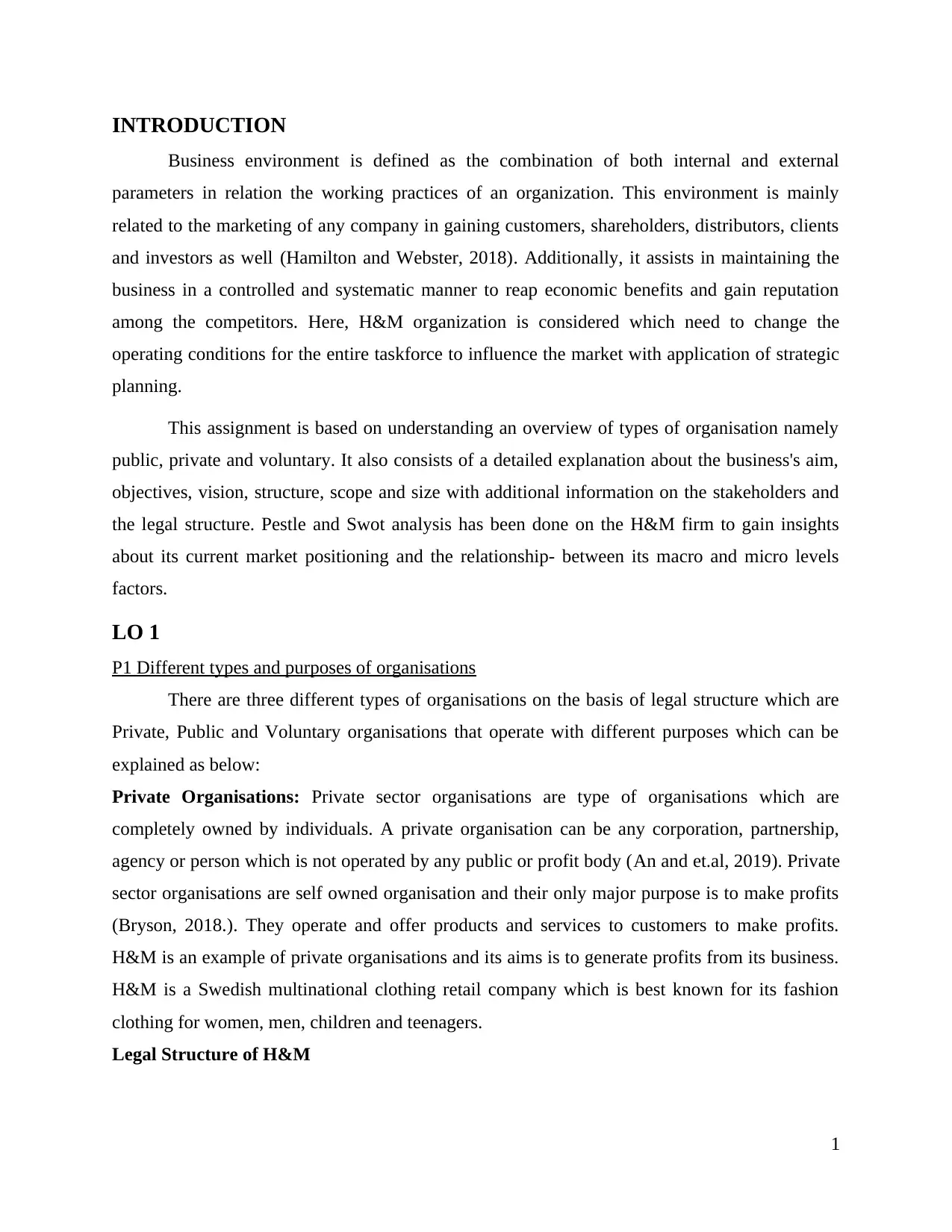
INTRODUCTION
Business environment is defined as the combination of both internal and external
parameters in relation the working practices of an organization. This environment is mainly
related to the marketing of any company in gaining customers, shareholders, distributors, clients
and investors as well (Hamilton and Webster, 2018). Additionally, it assists in maintaining the
business in a controlled and systematic manner to reap economic benefits and gain reputation
among the competitors. Here, H&M organization is considered which need to change the
operating conditions for the entire taskforce to influence the market with application of strategic
planning.
This assignment is based on understanding an overview of types of organisation namely
public, private and voluntary. It also consists of a detailed explanation about the business's aim,
objectives, vision, structure, scope and size with additional information on the stakeholders and
the legal structure. Pestle and Swot analysis has been done on the H&M firm to gain insights
about its current market positioning and the relationship- between its macro and micro levels
factors.
LO 1
P1 Different types and purposes of organisations
There are three different types of organisations on the basis of legal structure which are
Private, Public and Voluntary organisations that operate with different purposes which can be
explained as below:
Private Organisations: Private sector organisations are type of organisations which are
completely owned by individuals. A private organisation can be any corporation, partnership,
agency or person which is not operated by any public or profit body (An and et.al, 2019). Private
sector organisations are self owned organisation and their only major purpose is to make profits
(Bryson, 2018.). They operate and offer products and services to customers to make profits.
H&M is an example of private organisations and its aims is to generate profits from its business.
H&M is a Swedish multinational clothing retail company which is best known for its fashion
clothing for women, men, children and teenagers.
Legal Structure of H&M
1
Business environment is defined as the combination of both internal and external
parameters in relation the working practices of an organization. This environment is mainly
related to the marketing of any company in gaining customers, shareholders, distributors, clients
and investors as well (Hamilton and Webster, 2018). Additionally, it assists in maintaining the
business in a controlled and systematic manner to reap economic benefits and gain reputation
among the competitors. Here, H&M organization is considered which need to change the
operating conditions for the entire taskforce to influence the market with application of strategic
planning.
This assignment is based on understanding an overview of types of organisation namely
public, private and voluntary. It also consists of a detailed explanation about the business's aim,
objectives, vision, structure, scope and size with additional information on the stakeholders and
the legal structure. Pestle and Swot analysis has been done on the H&M firm to gain insights
about its current market positioning and the relationship- between its macro and micro levels
factors.
LO 1
P1 Different types and purposes of organisations
There are three different types of organisations on the basis of legal structure which are
Private, Public and Voluntary organisations that operate with different purposes which can be
explained as below:
Private Organisations: Private sector organisations are type of organisations which are
completely owned by individuals. A private organisation can be any corporation, partnership,
agency or person which is not operated by any public or profit body (An and et.al, 2019). Private
sector organisations are self owned organisation and their only major purpose is to make profits
(Bryson, 2018.). They operate and offer products and services to customers to make profits.
H&M is an example of private organisations and its aims is to generate profits from its business.
H&M is a Swedish multinational clothing retail company which is best known for its fashion
clothing for women, men, children and teenagers.
Legal Structure of H&M
1
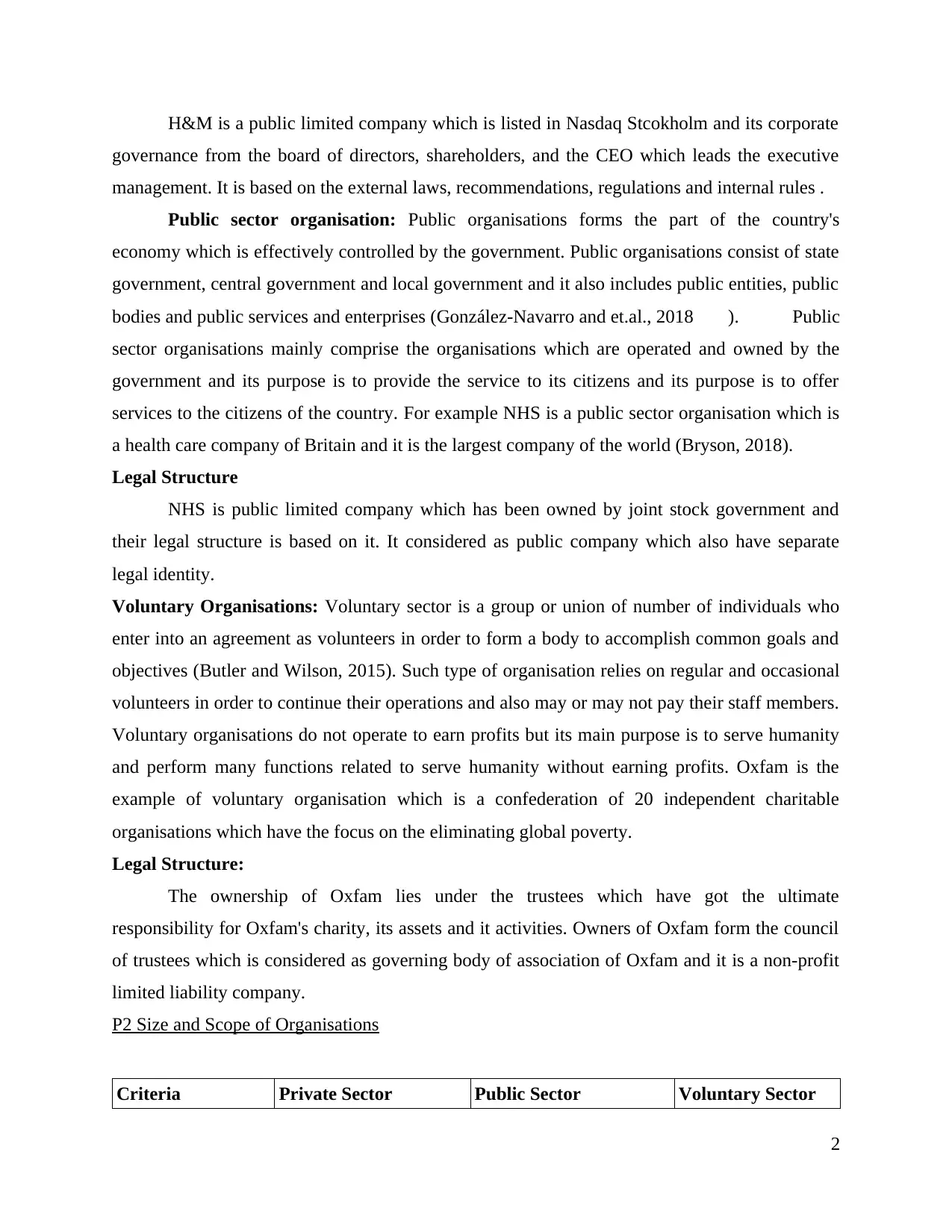
H&M is a public limited company which is listed in Nasdaq Stcokholm and its corporate
governance from the board of directors, shareholders, and the CEO which leads the executive
management. It is based on the external laws, recommendations, regulations and internal rules .
Public sector organisation: Public organisations forms the part of the country's
economy which is effectively controlled by the government. Public organisations consist of state
government, central government and local government and it also includes public entities, public
bodies and public services and enterprises (González-Navarro and et.al., 2018 ). Public
sector organisations mainly comprise the organisations which are operated and owned by the
government and its purpose is to provide the service to its citizens and its purpose is to offer
services to the citizens of the country. For example NHS is a public sector organisation which is
a health care company of Britain and it is the largest company of the world (Bryson, 2018).
Legal Structure
NHS is public limited company which has been owned by joint stock government and
their legal structure is based on it. It considered as public company which also have separate
legal identity.
Voluntary Organisations: Voluntary sector is a group or union of number of individuals who
enter into an agreement as volunteers in order to form a body to accomplish common goals and
objectives (Butler and Wilson, 2015). Such type of organisation relies on regular and occasional
volunteers in order to continue their operations and also may or may not pay their staff members.
Voluntary organisations do not operate to earn profits but its main purpose is to serve humanity
and perform many functions related to serve humanity without earning profits. Oxfam is the
example of voluntary organisation which is a confederation of 20 independent charitable
organisations which have the focus on the eliminating global poverty.
Legal Structure:
The ownership of Oxfam lies under the trustees which have got the ultimate
responsibility for Oxfam's charity, its assets and it activities. Owners of Oxfam form the council
of trustees which is considered as governing body of association of Oxfam and it is a non-profit
limited liability company.
P2 Size and Scope of Organisations
Criteria Private Sector Public Sector Voluntary Sector
2
governance from the board of directors, shareholders, and the CEO which leads the executive
management. It is based on the external laws, recommendations, regulations and internal rules .
Public sector organisation: Public organisations forms the part of the country's
economy which is effectively controlled by the government. Public organisations consist of state
government, central government and local government and it also includes public entities, public
bodies and public services and enterprises (González-Navarro and et.al., 2018 ). Public
sector organisations mainly comprise the organisations which are operated and owned by the
government and its purpose is to provide the service to its citizens and its purpose is to offer
services to the citizens of the country. For example NHS is a public sector organisation which is
a health care company of Britain and it is the largest company of the world (Bryson, 2018).
Legal Structure
NHS is public limited company which has been owned by joint stock government and
their legal structure is based on it. It considered as public company which also have separate
legal identity.
Voluntary Organisations: Voluntary sector is a group or union of number of individuals who
enter into an agreement as volunteers in order to form a body to accomplish common goals and
objectives (Butler and Wilson, 2015). Such type of organisation relies on regular and occasional
volunteers in order to continue their operations and also may or may not pay their staff members.
Voluntary organisations do not operate to earn profits but its main purpose is to serve humanity
and perform many functions related to serve humanity without earning profits. Oxfam is the
example of voluntary organisation which is a confederation of 20 independent charitable
organisations which have the focus on the eliminating global poverty.
Legal Structure:
The ownership of Oxfam lies under the trustees which have got the ultimate
responsibility for Oxfam's charity, its assets and it activities. Owners of Oxfam form the council
of trustees which is considered as governing body of association of Oxfam and it is a non-profit
limited liability company.
P2 Size and Scope of Organisations
Criteria Private Sector Public Sector Voluntary Sector
2
Secure Best Marks with AI Grader
Need help grading? Try our AI Grader for instant feedback on your assignments.
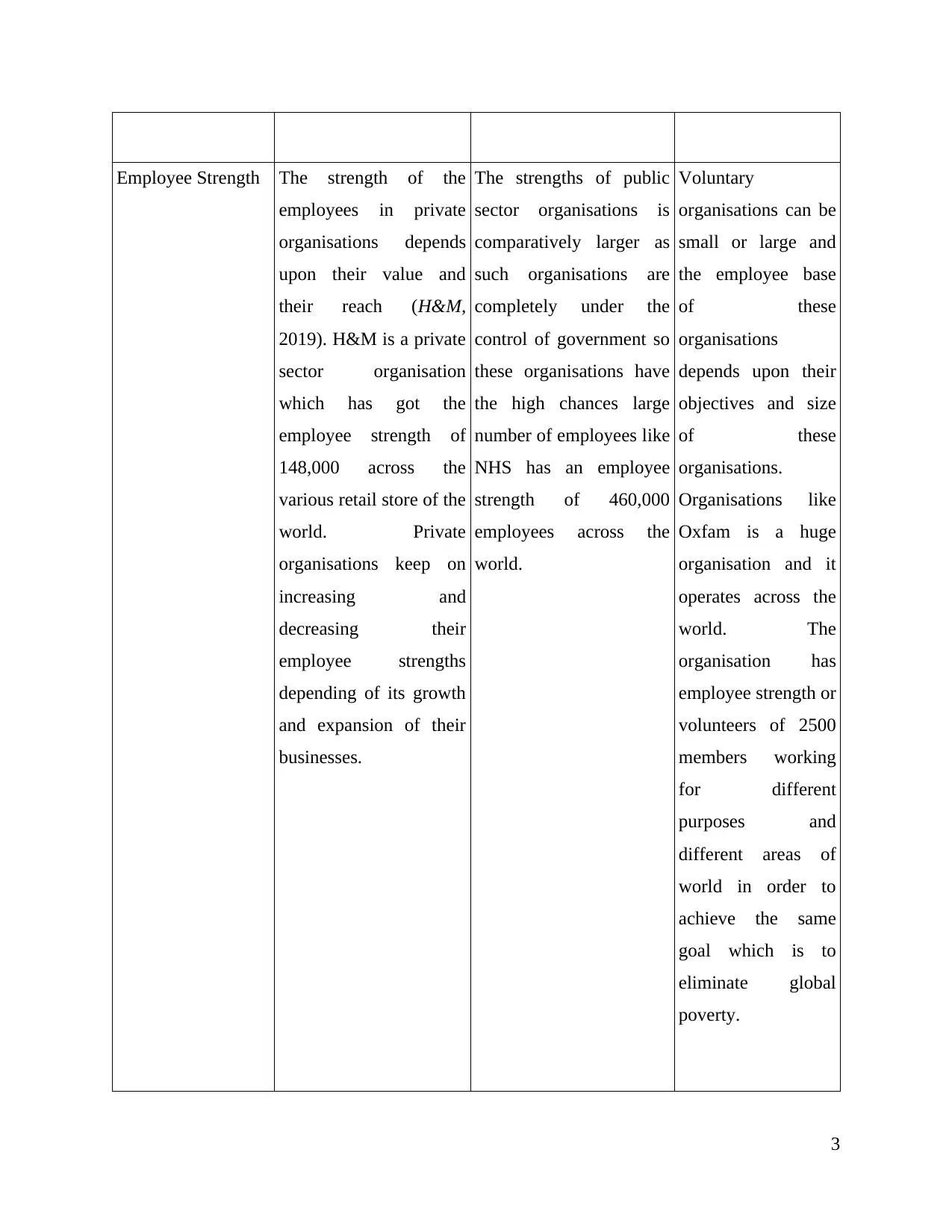
Employee Strength The strength of the
employees in private
organisations depends
upon their value and
their reach (H&M,
2019). H&M is a private
sector organisation
which has got the
employee strength of
148,000 across the
various retail store of the
world. Private
organisations keep on
increasing and
decreasing their
employee strengths
depending of its growth
and expansion of their
businesses.
The strengths of public
sector organisations is
comparatively larger as
such organisations are
completely under the
control of government so
these organisations have
the high chances large
number of employees like
NHS has an employee
strength of 460,000
employees across the
world.
Voluntary
organisations can be
small or large and
the employee base
of these
organisations
depends upon their
objectives and size
of these
organisations.
Organisations like
Oxfam is a huge
organisation and it
operates across the
world. The
organisation has
employee strength or
volunteers of 2500
members working
for different
purposes and
different areas of
world in order to
achieve the same
goal which is to
eliminate global
poverty.
3
employees in private
organisations depends
upon their value and
their reach (H&M,
2019). H&M is a private
sector organisation
which has got the
employee strength of
148,000 across the
various retail store of the
world. Private
organisations keep on
increasing and
decreasing their
employee strengths
depending of its growth
and expansion of their
businesses.
The strengths of public
sector organisations is
comparatively larger as
such organisations are
completely under the
control of government so
these organisations have
the high chances large
number of employees like
NHS has an employee
strength of 460,000
employees across the
world.
Voluntary
organisations can be
small or large and
the employee base
of these
organisations
depends upon their
objectives and size
of these
organisations.
Organisations like
Oxfam is a huge
organisation and it
operates across the
world. The
organisation has
employee strength or
volunteers of 2500
members working
for different
purposes and
different areas of
world in order to
achieve the same
goal which is to
eliminate global
poverty.
3

Revenue H&M owns large
number of retail stores
across the world and
generates huge amount
of revenue from its retail
stores. H&M is able to
generate revenue enough
to achieve its goal which
is making profits. H&M
generated the total
revenue of US $25.191
billion (2016).
NHS being public
organisation it has the
capacity to provide better
services for achieving its
aims ad business
objectives.
Being a huge
voluntary
organisation Oxfam
earned the revenue
of $463 million they
makes one of the
high revenue
generating voluntary
organisation in the
world. Revenue of
voluntary
organisation is
mostly provided to
its growth and
prosperity.
Market Size The size of market of
H&M is huge, H&M
and its associated
companies operates in
more than 62 countries
of the world and has got
more than 45,000 stores
which makes it the
second largest global
retailing company of the
world.
NHS has works since
early 90's and keeps on
expanding continuously
in different parts of the
world and covers a huge
social area.
Voluntary
organisations in
general do not have
a large market size.
But they serve in
communities or
markets. Oxfam
considered one of
the largest voluntary
organisation which
does not only
operate in UK but
4
number of retail stores
across the world and
generates huge amount
of revenue from its retail
stores. H&M is able to
generate revenue enough
to achieve its goal which
is making profits. H&M
generated the total
revenue of US $25.191
billion (2016).
NHS being public
organisation it has the
capacity to provide better
services for achieving its
aims ad business
objectives.
Being a huge
voluntary
organisation Oxfam
earned the revenue
of $463 million they
makes one of the
high revenue
generating voluntary
organisation in the
world. Revenue of
voluntary
organisation is
mostly provided to
its growth and
prosperity.
Market Size The size of market of
H&M is huge, H&M
and its associated
companies operates in
more than 62 countries
of the world and has got
more than 45,000 stores
which makes it the
second largest global
retailing company of the
world.
NHS has works since
early 90's and keeps on
expanding continuously
in different parts of the
world and covers a huge
social area.
Voluntary
organisations in
general do not have
a large market size.
But they serve in
communities or
markets. Oxfam
considered one of
the largest voluntary
organisation which
does not only
operate in UK but
4
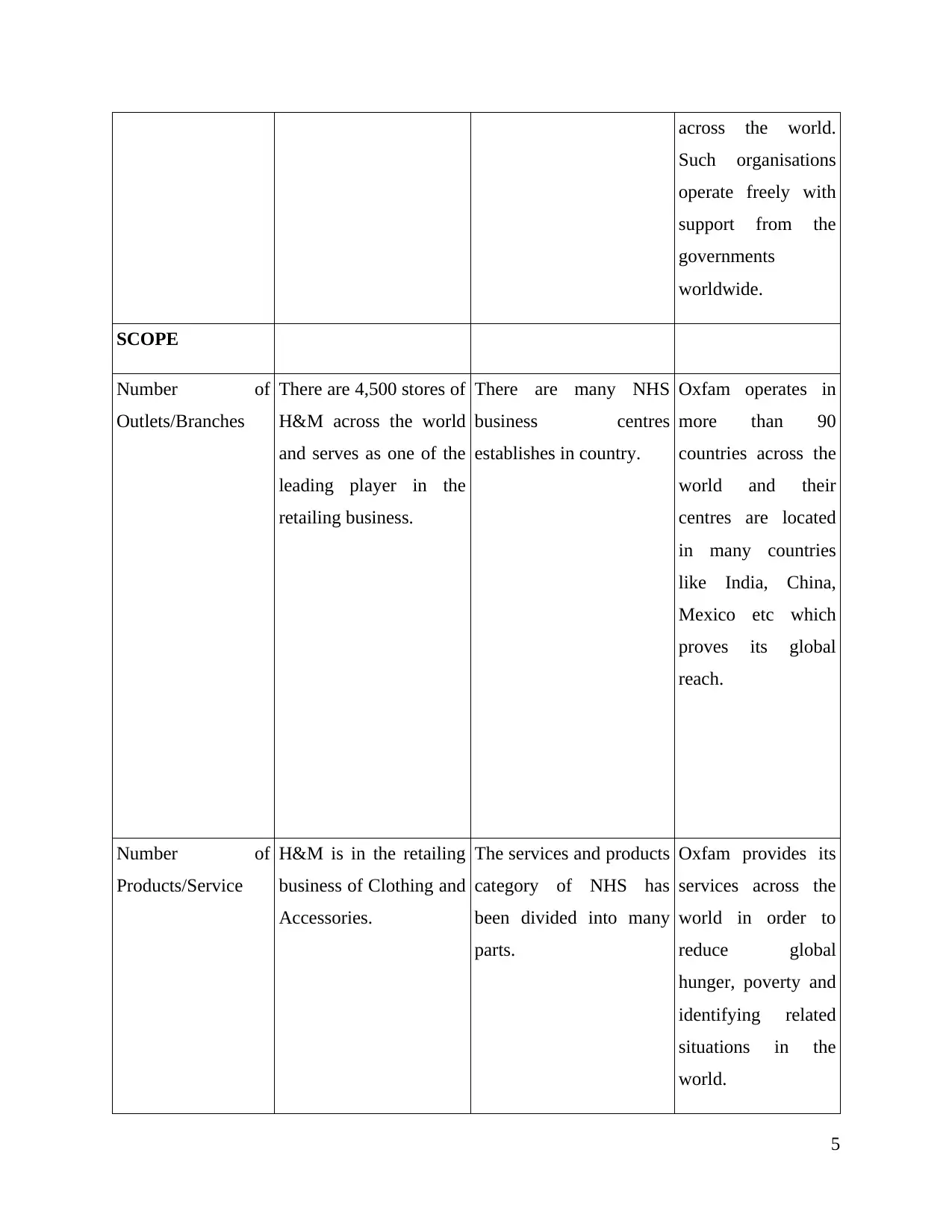
across the world.
Such organisations
operate freely with
support from the
governments
worldwide.
SCOPE
Number of
Outlets/Branches
There are 4,500 stores of
H&M across the world
and serves as one of the
leading player in the
retailing business.
There are many NHS
business centres
establishes in country.
Oxfam operates in
more than 90
countries across the
world and their
centres are located
in many countries
like India, China,
Mexico etc which
proves its global
reach.
Number of
Products/Service
H&M is in the retailing
business of Clothing and
Accessories.
The services and products
category of NHS has
been divided into many
parts.
Oxfam provides its
services across the
world in order to
reduce global
hunger, poverty and
identifying related
situations in the
world.
5
Such organisations
operate freely with
support from the
governments
worldwide.
SCOPE
Number of
Outlets/Branches
There are 4,500 stores of
H&M across the world
and serves as one of the
leading player in the
retailing business.
There are many NHS
business centres
establishes in country.
Oxfam operates in
more than 90
countries across the
world and their
centres are located
in many countries
like India, China,
Mexico etc which
proves its global
reach.
Number of
Products/Service
H&M is in the retailing
business of Clothing and
Accessories.
The services and products
category of NHS has
been divided into many
parts.
Oxfam provides its
services across the
world in order to
reduce global
hunger, poverty and
identifying related
situations in the
world.
5
Paraphrase This Document
Need a fresh take? Get an instant paraphrase of this document with our AI Paraphraser
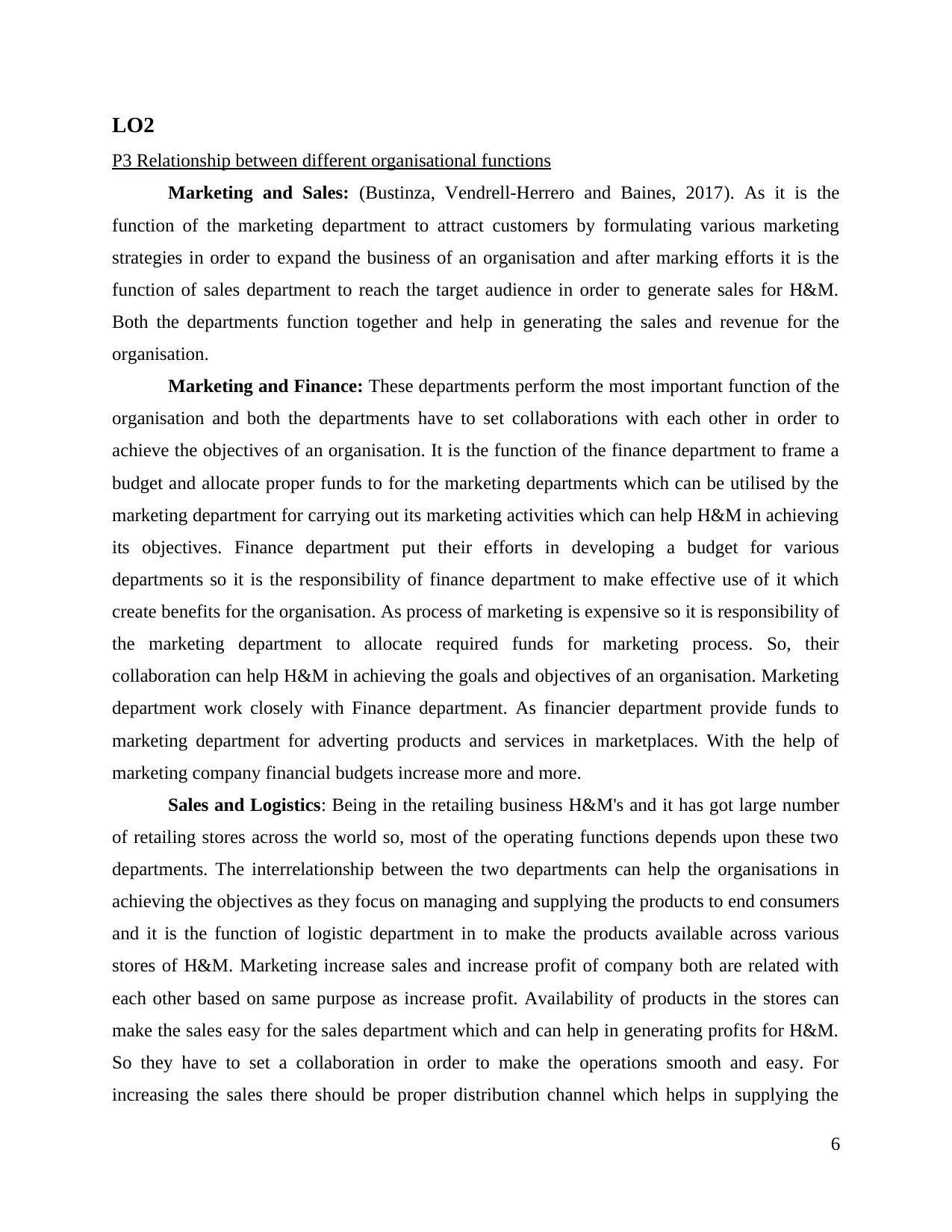
LO2
P3 Relationship between different organisational functions
Marketing and Sales: (Bustinza, Vendrell-Herrero and Baines, 2017). As it is the
function of the marketing department to attract customers by formulating various marketing
strategies in order to expand the business of an organisation and after marking efforts it is the
function of sales department to reach the target audience in order to generate sales for H&M.
Both the departments function together and help in generating the sales and revenue for the
organisation.
Marketing and Finance: These departments perform the most important function of the
organisation and both the departments have to set collaborations with each other in order to
achieve the objectives of an organisation. It is the function of the finance department to frame a
budget and allocate proper funds to for the marketing departments which can be utilised by the
marketing department for carrying out its marketing activities which can help H&M in achieving
its objectives. Finance department put their efforts in developing a budget for various
departments so it is the responsibility of finance department to make effective use of it which
create benefits for the organisation. As process of marketing is expensive so it is responsibility of
the marketing department to allocate required funds for marketing process. So, their
collaboration can help H&M in achieving the goals and objectives of an organisation. Marketing
department work closely with Finance department. As financier department provide funds to
marketing department for adverting products and services in marketplaces. With the help of
marketing company financial budgets increase more and more.
Sales and Logistics: Being in the retailing business H&M's and it has got large number
of retailing stores across the world so, most of the operating functions depends upon these two
departments. The interrelationship between the two departments can help the organisations in
achieving the objectives as they focus on managing and supplying the products to end consumers
and it is the function of logistic department in to make the products available across various
stores of H&M. Marketing increase sales and increase profit of company both are related with
each other based on same purpose as increase profit. Availability of products in the stores can
make the sales easy for the sales department which and can help in generating profits for H&M.
So they have to set a collaboration in order to make the operations smooth and easy. For
increasing the sales there should be proper distribution channel which helps in supplying the
6
P3 Relationship between different organisational functions
Marketing and Sales: (Bustinza, Vendrell-Herrero and Baines, 2017). As it is the
function of the marketing department to attract customers by formulating various marketing
strategies in order to expand the business of an organisation and after marking efforts it is the
function of sales department to reach the target audience in order to generate sales for H&M.
Both the departments function together and help in generating the sales and revenue for the
organisation.
Marketing and Finance: These departments perform the most important function of the
organisation and both the departments have to set collaborations with each other in order to
achieve the objectives of an organisation. It is the function of the finance department to frame a
budget and allocate proper funds to for the marketing departments which can be utilised by the
marketing department for carrying out its marketing activities which can help H&M in achieving
its objectives. Finance department put their efforts in developing a budget for various
departments so it is the responsibility of finance department to make effective use of it which
create benefits for the organisation. As process of marketing is expensive so it is responsibility of
the marketing department to allocate required funds for marketing process. So, their
collaboration can help H&M in achieving the goals and objectives of an organisation. Marketing
department work closely with Finance department. As financier department provide funds to
marketing department for adverting products and services in marketplaces. With the help of
marketing company financial budgets increase more and more.
Sales and Logistics: Being in the retailing business H&M's and it has got large number
of retailing stores across the world so, most of the operating functions depends upon these two
departments. The interrelationship between the two departments can help the organisations in
achieving the objectives as they focus on managing and supplying the products to end consumers
and it is the function of logistic department in to make the products available across various
stores of H&M. Marketing increase sales and increase profit of company both are related with
each other based on same purpose as increase profit. Availability of products in the stores can
make the sales easy for the sales department which and can help in generating profits for H&M.
So they have to set a collaboration in order to make the operations smooth and easy. For
increasing the sales there should be proper distribution channel which helps in supplying the
6
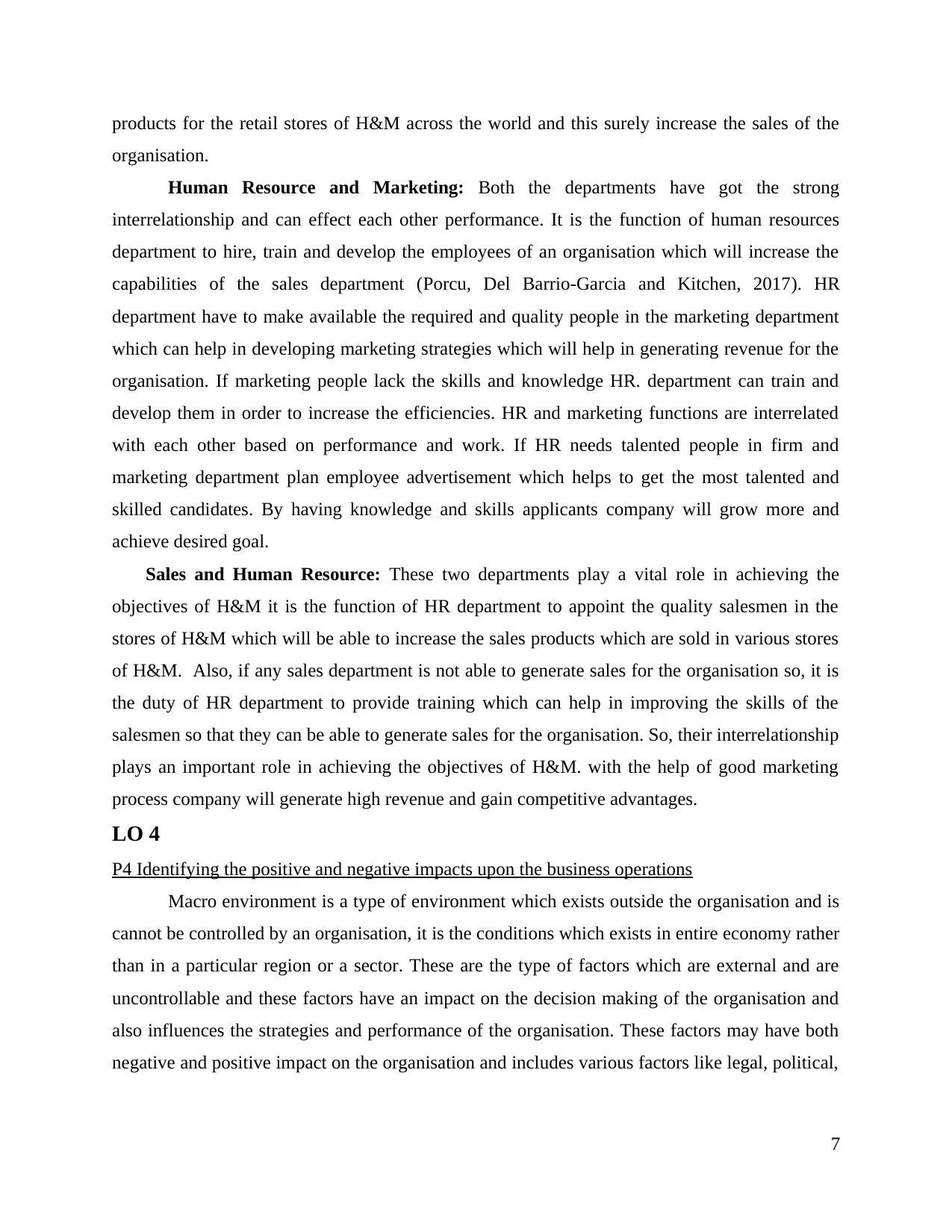
products for the retail stores of H&M across the world and this surely increase the sales of the
organisation.
Human Resource and Marketing: Both the departments have got the strong
interrelationship and can effect each other performance. It is the function of human resources
department to hire, train and develop the employees of an organisation which will increase the
capabilities of the sales department (Porcu, Del Barrio-Garcia and Kitchen, 2017). HR
department have to make available the required and quality people in the marketing department
which can help in developing marketing strategies which will help in generating revenue for the
organisation. If marketing people lack the skills and knowledge HR. department can train and
develop them in order to increase the efficiencies. HR and marketing functions are interrelated
with each other based on performance and work. If HR needs talented people in firm and
marketing department plan employee advertisement which helps to get the most talented and
skilled candidates. By having knowledge and skills applicants company will grow more and
achieve desired goal.
Sales and Human Resource: These two departments play a vital role in achieving the
objectives of H&M it is the function of HR department to appoint the quality salesmen in the
stores of H&M which will be able to increase the sales products which are sold in various stores
of H&M. Also, if any sales department is not able to generate sales for the organisation so, it is
the duty of HR department to provide training which can help in improving the skills of the
salesmen so that they can be able to generate sales for the organisation. So, their interrelationship
plays an important role in achieving the objectives of H&M. with the help of good marketing
process company will generate high revenue and gain competitive advantages.
LO 4
P4 Identifying the positive and negative impacts upon the business operations
Macro environment is a type of environment which exists outside the organisation and is
cannot be controlled by an organisation, it is the conditions which exists in entire economy rather
than in a particular region or a sector. These are the type of factors which are external and are
uncontrollable and these factors have an impact on the decision making of the organisation and
also influences the strategies and performance of the organisation. These factors may have both
negative and positive impact on the organisation and includes various factors like legal, political,
7
organisation.
Human Resource and Marketing: Both the departments have got the strong
interrelationship and can effect each other performance. It is the function of human resources
department to hire, train and develop the employees of an organisation which will increase the
capabilities of the sales department (Porcu, Del Barrio-Garcia and Kitchen, 2017). HR
department have to make available the required and quality people in the marketing department
which can help in developing marketing strategies which will help in generating revenue for the
organisation. If marketing people lack the skills and knowledge HR. department can train and
develop them in order to increase the efficiencies. HR and marketing functions are interrelated
with each other based on performance and work. If HR needs talented people in firm and
marketing department plan employee advertisement which helps to get the most talented and
skilled candidates. By having knowledge and skills applicants company will grow more and
achieve desired goal.
Sales and Human Resource: These two departments play a vital role in achieving the
objectives of H&M it is the function of HR department to appoint the quality salesmen in the
stores of H&M which will be able to increase the sales products which are sold in various stores
of H&M. Also, if any sales department is not able to generate sales for the organisation so, it is
the duty of HR department to provide training which can help in improving the skills of the
salesmen so that they can be able to generate sales for the organisation. So, their interrelationship
plays an important role in achieving the objectives of H&M. with the help of good marketing
process company will generate high revenue and gain competitive advantages.
LO 4
P4 Identifying the positive and negative impacts upon the business operations
Macro environment is a type of environment which exists outside the organisation and is
cannot be controlled by an organisation, it is the conditions which exists in entire economy rather
than in a particular region or a sector. These are the type of factors which are external and are
uncontrollable and these factors have an impact on the decision making of the organisation and
also influences the strategies and performance of the organisation. These factors may have both
negative and positive impact on the organisation and includes various factors like legal, political,
7
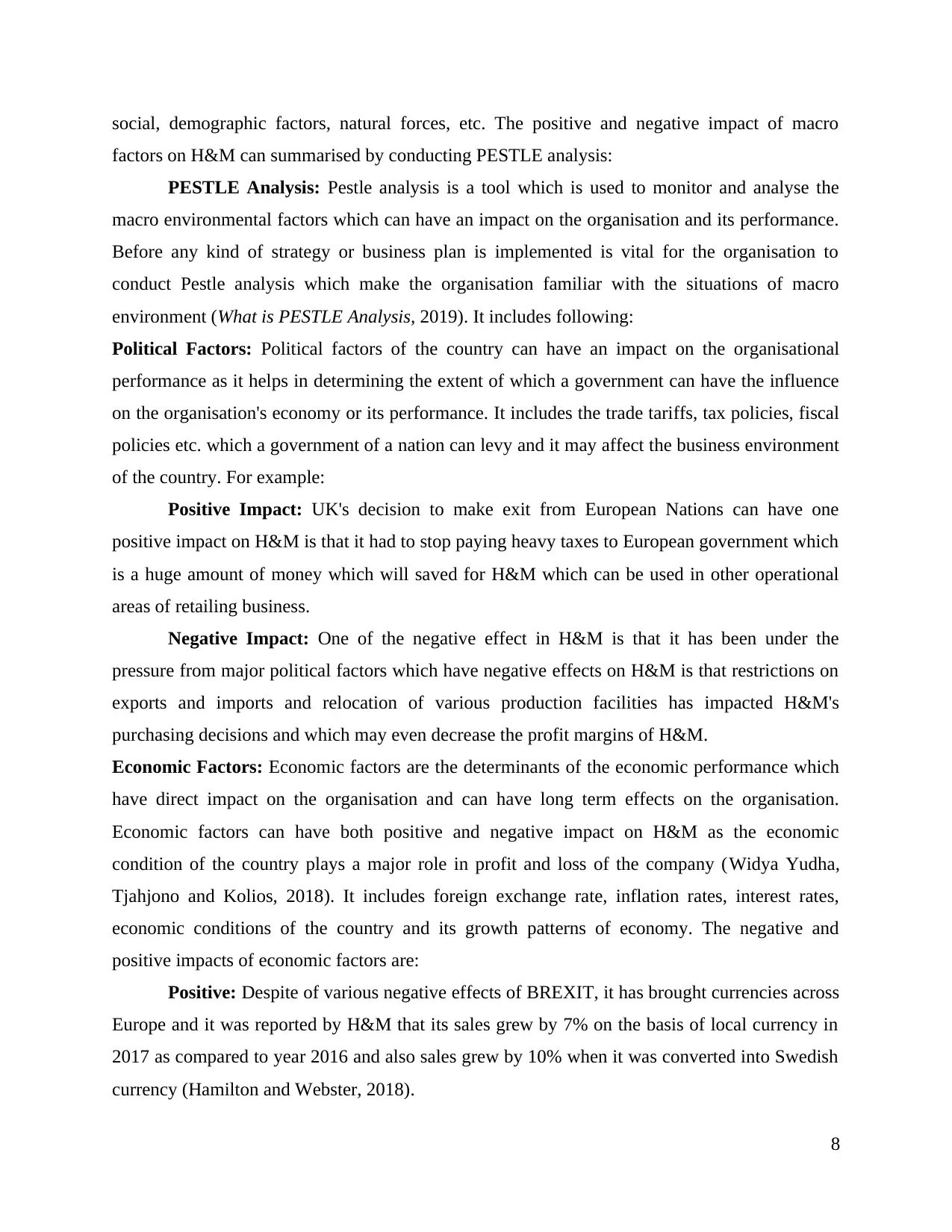
social, demographic factors, natural forces, etc. The positive and negative impact of macro
factors on H&M can summarised by conducting PESTLE analysis:
PESTLE Analysis: Pestle analysis is a tool which is used to monitor and analyse the
macro environmental factors which can have an impact on the organisation and its performance.
Before any kind of strategy or business plan is implemented is vital for the organisation to
conduct Pestle analysis which make the organisation familiar with the situations of macro
environment (What is PESTLE Analysis, 2019). It includes following:
Political Factors: Political factors of the country can have an impact on the organisational
performance as it helps in determining the extent of which a government can have the influence
on the organisation's economy or its performance. It includes the trade tariffs, tax policies, fiscal
policies etc. which a government of a nation can levy and it may affect the business environment
of the country. For example:
Positive Impact: UK's decision to make exit from European Nations can have one
positive impact on H&M is that it had to stop paying heavy taxes to European government which
is a huge amount of money which will saved for H&M which can be used in other operational
areas of retailing business.
Negative Impact: One of the negative effect in H&M is that it has been under the
pressure from major political factors which have negative effects on H&M is that restrictions on
exports and imports and relocation of various production facilities has impacted H&M's
purchasing decisions and which may even decrease the profit margins of H&M.
Economic Factors: Economic factors are the determinants of the economic performance which
have direct impact on the organisation and can have long term effects on the organisation.
Economic factors can have both positive and negative impact on H&M as the economic
condition of the country plays a major role in profit and loss of the company (Widya Yudha,
Tjahjono and Kolios, 2018). It includes foreign exchange rate, inflation rates, interest rates,
economic conditions of the country and its growth patterns of economy. The negative and
positive impacts of economic factors are:
Positive: Despite of various negative effects of BREXIT, it has brought currencies across
Europe and it was reported by H&M that its sales grew by 7% on the basis of local currency in
2017 as compared to year 2016 and also sales grew by 10% when it was converted into Swedish
currency (Hamilton and Webster, 2018).
8
factors on H&M can summarised by conducting PESTLE analysis:
PESTLE Analysis: Pestle analysis is a tool which is used to monitor and analyse the
macro environmental factors which can have an impact on the organisation and its performance.
Before any kind of strategy or business plan is implemented is vital for the organisation to
conduct Pestle analysis which make the organisation familiar with the situations of macro
environment (What is PESTLE Analysis, 2019). It includes following:
Political Factors: Political factors of the country can have an impact on the organisational
performance as it helps in determining the extent of which a government can have the influence
on the organisation's economy or its performance. It includes the trade tariffs, tax policies, fiscal
policies etc. which a government of a nation can levy and it may affect the business environment
of the country. For example:
Positive Impact: UK's decision to make exit from European Nations can have one
positive impact on H&M is that it had to stop paying heavy taxes to European government which
is a huge amount of money which will saved for H&M which can be used in other operational
areas of retailing business.
Negative Impact: One of the negative effect in H&M is that it has been under the
pressure from major political factors which have negative effects on H&M is that restrictions on
exports and imports and relocation of various production facilities has impacted H&M's
purchasing decisions and which may even decrease the profit margins of H&M.
Economic Factors: Economic factors are the determinants of the economic performance which
have direct impact on the organisation and can have long term effects on the organisation.
Economic factors can have both positive and negative impact on H&M as the economic
condition of the country plays a major role in profit and loss of the company (Widya Yudha,
Tjahjono and Kolios, 2018). It includes foreign exchange rate, inflation rates, interest rates,
economic conditions of the country and its growth patterns of economy. The negative and
positive impacts of economic factors are:
Positive: Despite of various negative effects of BREXIT, it has brought currencies across
Europe and it was reported by H&M that its sales grew by 7% on the basis of local currency in
2017 as compared to year 2016 and also sales grew by 10% when it was converted into Swedish
currency (Hamilton and Webster, 2018).
8
Secure Best Marks with AI Grader
Need help grading? Try our AI Grader for instant feedback on your assignments.
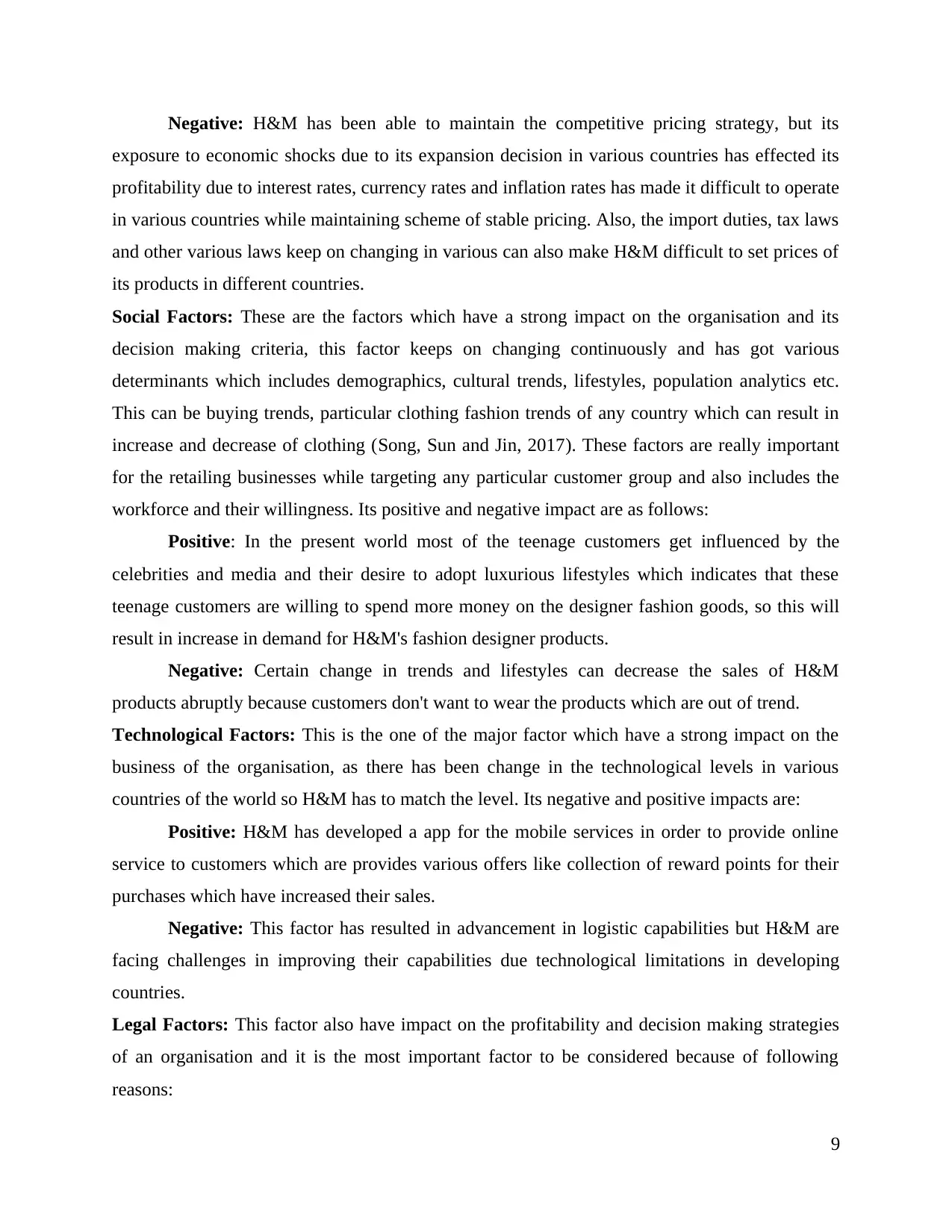
Negative: H&M has been able to maintain the competitive pricing strategy, but its
exposure to economic shocks due to its expansion decision in various countries has effected its
profitability due to interest rates, currency rates and inflation rates has made it difficult to operate
in various countries while maintaining scheme of stable pricing. Also, the import duties, tax laws
and other various laws keep on changing in various can also make H&M difficult to set prices of
its products in different countries.
Social Factors: These are the factors which have a strong impact on the organisation and its
decision making criteria, this factor keeps on changing continuously and has got various
determinants which includes demographics, cultural trends, lifestyles, population analytics etc.
This can be buying trends, particular clothing fashion trends of any country which can result in
increase and decrease of clothing (Song, Sun and Jin, 2017). These factors are really important
for the retailing businesses while targeting any particular customer group and also includes the
workforce and their willingness. Its positive and negative impact are as follows:
Positive: In the present world most of the teenage customers get influenced by the
celebrities and media and their desire to adopt luxurious lifestyles which indicates that these
teenage customers are willing to spend more money on the designer fashion goods, so this will
result in increase in demand for H&M's fashion designer products.
Negative: Certain change in trends and lifestyles can decrease the sales of H&M
products abruptly because customers don't want to wear the products which are out of trend.
Technological Factors: This is the one of the major factor which have a strong impact on the
business of the organisation, as there has been change in the technological levels in various
countries of the world so H&M has to match the level. Its negative and positive impacts are:
Positive: H&M has developed a app for the mobile services in order to provide online
service to customers which are provides various offers like collection of reward points for their
purchases which have increased their sales.
Negative: This factor has resulted in advancement in logistic capabilities but H&M are
facing challenges in improving their capabilities due technological limitations in developing
countries.
Legal Factors: This factor also have impact on the profitability and decision making strategies
of an organisation and it is the most important factor to be considered because of following
reasons:
9
exposure to economic shocks due to its expansion decision in various countries has effected its
profitability due to interest rates, currency rates and inflation rates has made it difficult to operate
in various countries while maintaining scheme of stable pricing. Also, the import duties, tax laws
and other various laws keep on changing in various can also make H&M difficult to set prices of
its products in different countries.
Social Factors: These are the factors which have a strong impact on the organisation and its
decision making criteria, this factor keeps on changing continuously and has got various
determinants which includes demographics, cultural trends, lifestyles, population analytics etc.
This can be buying trends, particular clothing fashion trends of any country which can result in
increase and decrease of clothing (Song, Sun and Jin, 2017). These factors are really important
for the retailing businesses while targeting any particular customer group and also includes the
workforce and their willingness. Its positive and negative impact are as follows:
Positive: In the present world most of the teenage customers get influenced by the
celebrities and media and their desire to adopt luxurious lifestyles which indicates that these
teenage customers are willing to spend more money on the designer fashion goods, so this will
result in increase in demand for H&M's fashion designer products.
Negative: Certain change in trends and lifestyles can decrease the sales of H&M
products abruptly because customers don't want to wear the products which are out of trend.
Technological Factors: This is the one of the major factor which have a strong impact on the
business of the organisation, as there has been change in the technological levels in various
countries of the world so H&M has to match the level. Its negative and positive impacts are:
Positive: H&M has developed a app for the mobile services in order to provide online
service to customers which are provides various offers like collection of reward points for their
purchases which have increased their sales.
Negative: This factor has resulted in advancement in logistic capabilities but H&M are
facing challenges in improving their capabilities due technological limitations in developing
countries.
Legal Factors: This factor also have impact on the profitability and decision making strategies
of an organisation and it is the most important factor to be considered because of following
reasons:
9
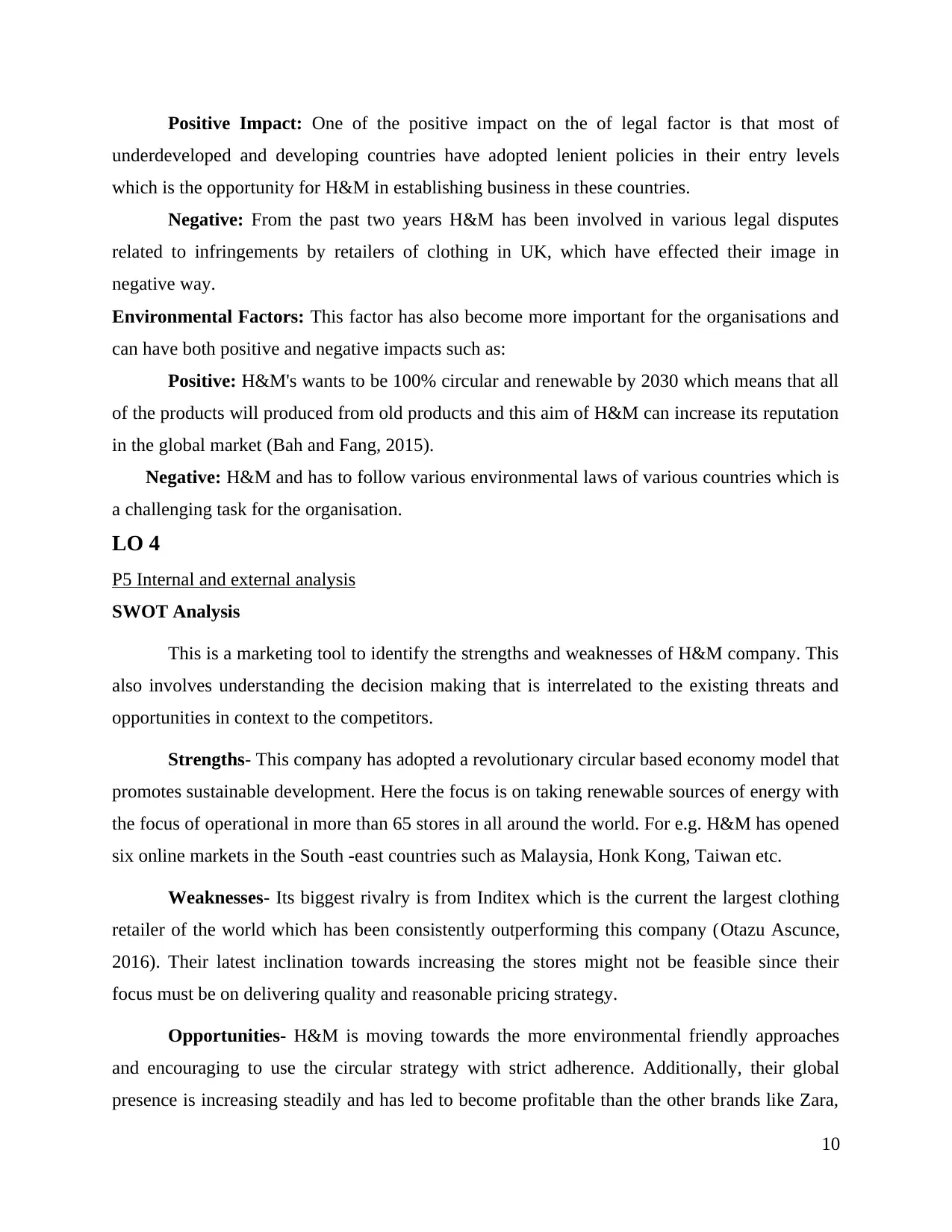
Positive Impact: One of the positive impact on the of legal factor is that most of
underdeveloped and developing countries have adopted lenient policies in their entry levels
which is the opportunity for H&M in establishing business in these countries.
Negative: From the past two years H&M has been involved in various legal disputes
related to infringements by retailers of clothing in UK, which have effected their image in
negative way.
Environmental Factors: This factor has also become more important for the organisations and
can have both positive and negative impacts such as:
Positive: H&M's wants to be 100% circular and renewable by 2030 which means that all
of the products will produced from old products and this aim of H&M can increase its reputation
in the global market (Bah and Fang, 2015).
Negative: H&M and has to follow various environmental laws of various countries which is
a challenging task for the organisation.
LO 4
P5 Internal and external analysis
SWOT Analysis
This is a marketing tool to identify the strengths and weaknesses of H&M company. This
also involves understanding the decision making that is interrelated to the existing threats and
opportunities in context to the competitors.
Strengths- This company has adopted a revolutionary circular based economy model that
promotes sustainable development. Here the focus is on taking renewable sources of energy with
the focus of operational in more than 65 stores in all around the world. For e.g. H&M has opened
six online markets in the South -east countries such as Malaysia, Honk Kong, Taiwan etc.
Weaknesses- Its biggest rivalry is from Inditex which is the current the largest clothing
retailer of the world which has been consistently outperforming this company (Otazu Ascunce,
2016). Their latest inclination towards increasing the stores might not be feasible since their
focus must be on delivering quality and reasonable pricing strategy.
Opportunities- H&M is moving towards the more environmental friendly approaches
and encouraging to use the circular strategy with strict adherence. Additionally, their global
presence is increasing steadily and has led to become profitable than the other brands like Zara,
10
underdeveloped and developing countries have adopted lenient policies in their entry levels
which is the opportunity for H&M in establishing business in these countries.
Negative: From the past two years H&M has been involved in various legal disputes
related to infringements by retailers of clothing in UK, which have effected their image in
negative way.
Environmental Factors: This factor has also become more important for the organisations and
can have both positive and negative impacts such as:
Positive: H&M's wants to be 100% circular and renewable by 2030 which means that all
of the products will produced from old products and this aim of H&M can increase its reputation
in the global market (Bah and Fang, 2015).
Negative: H&M and has to follow various environmental laws of various countries which is
a challenging task for the organisation.
LO 4
P5 Internal and external analysis
SWOT Analysis
This is a marketing tool to identify the strengths and weaknesses of H&M company. This
also involves understanding the decision making that is interrelated to the existing threats and
opportunities in context to the competitors.
Strengths- This company has adopted a revolutionary circular based economy model that
promotes sustainable development. Here the focus is on taking renewable sources of energy with
the focus of operational in more than 65 stores in all around the world. For e.g. H&M has opened
six online markets in the South -east countries such as Malaysia, Honk Kong, Taiwan etc.
Weaknesses- Its biggest rivalry is from Inditex which is the current the largest clothing
retailer of the world which has been consistently outperforming this company (Otazu Ascunce,
2016). Their latest inclination towards increasing the stores might not be feasible since their
focus must be on delivering quality and reasonable pricing strategy.
Opportunities- H&M is moving towards the more environmental friendly approaches
and encouraging to use the circular strategy with strict adherence. Additionally, their global
presence is increasing steadily and has led to become profitable than the other brands like Zara,
10
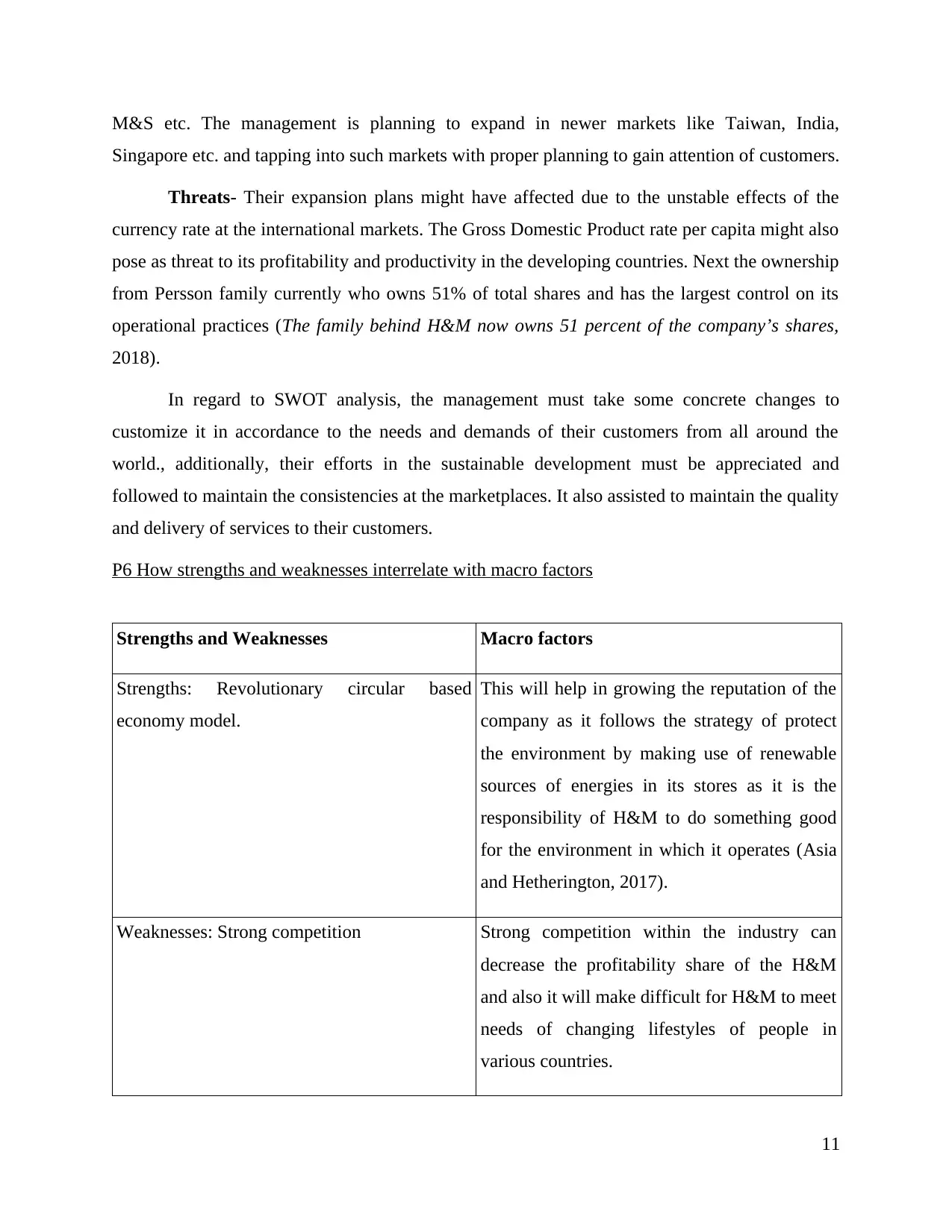
M&S etc. The management is planning to expand in newer markets like Taiwan, India,
Singapore etc. and tapping into such markets with proper planning to gain attention of customers.
Threats- Their expansion plans might have affected due to the unstable effects of the
currency rate at the international markets. The Gross Domestic Product rate per capita might also
pose as threat to its profitability and productivity in the developing countries. Next the ownership
from Persson family currently who owns 51% of total shares and has the largest control on its
operational practices (The family behind H&M now owns 51 percent of the company’s shares,
2018).
In regard to SWOT analysis, the management must take some concrete changes to
customize it in accordance to the needs and demands of their customers from all around the
world., additionally, their efforts in the sustainable development must be appreciated and
followed to maintain the consistencies at the marketplaces. It also assisted to maintain the quality
and delivery of services to their customers.
P6 How strengths and weaknesses interrelate with macro factors
Strengths and Weaknesses Macro factors
Strengths: Revolutionary circular based
economy model.
This will help in growing the reputation of the
company as it follows the strategy of protect
the environment by making use of renewable
sources of energies in its stores as it is the
responsibility of H&M to do something good
for the environment in which it operates (Asia
and Hetherington, 2017).
Weaknesses: Strong competition Strong competition within the industry can
decrease the profitability share of the H&M
and also it will make difficult for H&M to meet
needs of changing lifestyles of people in
various countries.
11
Singapore etc. and tapping into such markets with proper planning to gain attention of customers.
Threats- Their expansion plans might have affected due to the unstable effects of the
currency rate at the international markets. The Gross Domestic Product rate per capita might also
pose as threat to its profitability and productivity in the developing countries. Next the ownership
from Persson family currently who owns 51% of total shares and has the largest control on its
operational practices (The family behind H&M now owns 51 percent of the company’s shares,
2018).
In regard to SWOT analysis, the management must take some concrete changes to
customize it in accordance to the needs and demands of their customers from all around the
world., additionally, their efforts in the sustainable development must be appreciated and
followed to maintain the consistencies at the marketplaces. It also assisted to maintain the quality
and delivery of services to their customers.
P6 How strengths and weaknesses interrelate with macro factors
Strengths and Weaknesses Macro factors
Strengths: Revolutionary circular based
economy model.
This will help in growing the reputation of the
company as it follows the strategy of protect
the environment by making use of renewable
sources of energies in its stores as it is the
responsibility of H&M to do something good
for the environment in which it operates (Asia
and Hetherington, 2017).
Weaknesses: Strong competition Strong competition within the industry can
decrease the profitability share of the H&M
and also it will make difficult for H&M to meet
needs of changing lifestyles of people in
various countries.
11
Paraphrase This Document
Need a fresh take? Get an instant paraphrase of this document with our AI Paraphraser
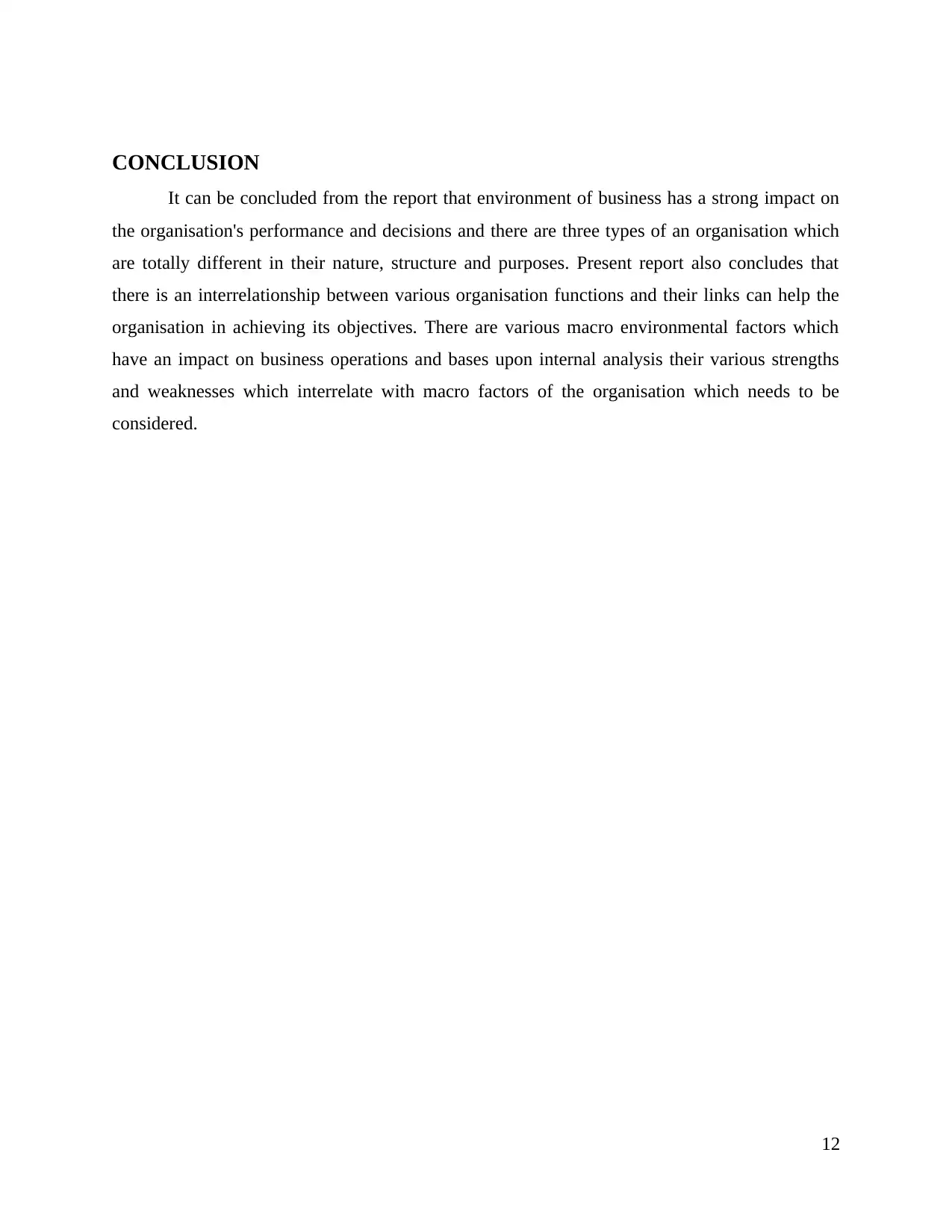
CONCLUSION
It can be concluded from the report that environment of business has a strong impact on
the organisation's performance and decisions and there are three types of an organisation which
are totally different in their nature, structure and purposes. Present report also concludes that
there is an interrelationship between various organisation functions and their links can help the
organisation in achieving its objectives. There are various macro environmental factors which
have an impact on business operations and bases upon internal analysis their various strengths
and weaknesses which interrelate with macro factors of the organisation which needs to be
considered.
12
It can be concluded from the report that environment of business has a strong impact on
the organisation's performance and decisions and there are three types of an organisation which
are totally different in their nature, structure and purposes. Present report also concludes that
there is an interrelationship between various organisation functions and their links can help the
organisation in achieving its objectives. There are various macro environmental factors which
have an impact on business operations and bases upon internal analysis their various strengths
and weaknesses which interrelate with macro factors of the organisation which needs to be
considered.
12
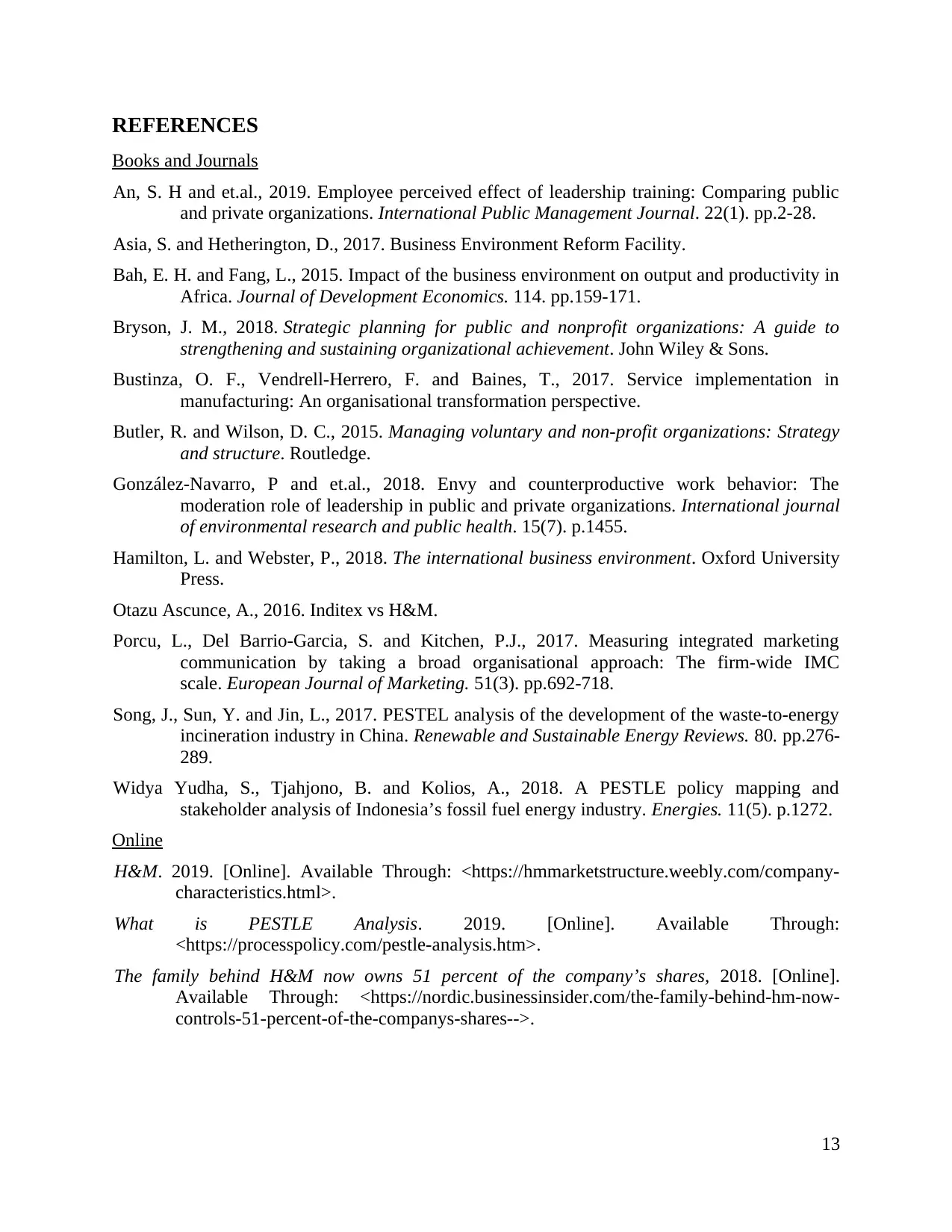
REFERENCES
Books and Journals
An, S. H and et.al., 2019. Employee perceived effect of leadership training: Comparing public
and private organizations. International Public Management Journal. 22(1). pp.2-28.
Asia, S. and Hetherington, D., 2017. Business Environment Reform Facility.
Bah, E. H. and Fang, L., 2015. Impact of the business environment on output and productivity in
Africa. Journal of Development Economics. 114. pp.159-171.
Bryson, J. M., 2018. Strategic planning for public and nonprofit organizations: A guide to
strengthening and sustaining organizational achievement. John Wiley & Sons.
Bustinza, O. F., Vendrell-Herrero, F. and Baines, T., 2017. Service implementation in
manufacturing: An organisational transformation perspective.
Butler, R. and Wilson, D. C., 2015. Managing voluntary and non-profit organizations: Strategy
and structure. Routledge.
González-Navarro, P and et.al., 2018. Envy and counterproductive work behavior: The
moderation role of leadership in public and private organizations. International journal
of environmental research and public health. 15(7). p.1455.
Hamilton, L. and Webster, P., 2018. The international business environment. Oxford University
Press.
Otazu Ascunce, A., 2016. Inditex vs H&M.
Porcu, L., Del Barrio-Garcia, S. and Kitchen, P.J., 2017. Measuring integrated marketing
communication by taking a broad organisational approach: The firm-wide IMC
scale. European Journal of Marketing. 51(3). pp.692-718.
Song, J., Sun, Y. and Jin, L., 2017. PESTEL analysis of the development of the waste-to-energy
incineration industry in China. Renewable and Sustainable Energy Reviews. 80. pp.276-
289.
Widya Yudha, S., Tjahjono, B. and Kolios, A., 2018. A PESTLE policy mapping and
stakeholder analysis of Indonesia’s fossil fuel energy industry. Energies. 11(5). p.1272.
Online
H&M. 2019. [Online]. Available Through: <https://hmmarketstructure.weebly.com/company-
characteristics.html>.
What is PESTLE Analysis. 2019. [Online]. Available Through:
<https://processpolicy.com/pestle-analysis.htm>.
The family behind H&M now owns 51 percent of the company’s shares, 2018. [Online].
Available Through: <https://nordic.businessinsider.com/the-family-behind-hm-now-
controls-51-percent-of-the-companys-shares-->.
13
Books and Journals
An, S. H and et.al., 2019. Employee perceived effect of leadership training: Comparing public
and private organizations. International Public Management Journal. 22(1). pp.2-28.
Asia, S. and Hetherington, D., 2017. Business Environment Reform Facility.
Bah, E. H. and Fang, L., 2015. Impact of the business environment on output and productivity in
Africa. Journal of Development Economics. 114. pp.159-171.
Bryson, J. M., 2018. Strategic planning for public and nonprofit organizations: A guide to
strengthening and sustaining organizational achievement. John Wiley & Sons.
Bustinza, O. F., Vendrell-Herrero, F. and Baines, T., 2017. Service implementation in
manufacturing: An organisational transformation perspective.
Butler, R. and Wilson, D. C., 2015. Managing voluntary and non-profit organizations: Strategy
and structure. Routledge.
González-Navarro, P and et.al., 2018. Envy and counterproductive work behavior: The
moderation role of leadership in public and private organizations. International journal
of environmental research and public health. 15(7). p.1455.
Hamilton, L. and Webster, P., 2018. The international business environment. Oxford University
Press.
Otazu Ascunce, A., 2016. Inditex vs H&M.
Porcu, L., Del Barrio-Garcia, S. and Kitchen, P.J., 2017. Measuring integrated marketing
communication by taking a broad organisational approach: The firm-wide IMC
scale. European Journal of Marketing. 51(3). pp.692-718.
Song, J., Sun, Y. and Jin, L., 2017. PESTEL analysis of the development of the waste-to-energy
incineration industry in China. Renewable and Sustainable Energy Reviews. 80. pp.276-
289.
Widya Yudha, S., Tjahjono, B. and Kolios, A., 2018. A PESTLE policy mapping and
stakeholder analysis of Indonesia’s fossil fuel energy industry. Energies. 11(5). p.1272.
Online
H&M. 2019. [Online]. Available Through: <https://hmmarketstructure.weebly.com/company-
characteristics.html>.
What is PESTLE Analysis. 2019. [Online]. Available Through:
<https://processpolicy.com/pestle-analysis.htm>.
The family behind H&M now owns 51 percent of the company’s shares, 2018. [Online].
Available Through: <https://nordic.businessinsider.com/the-family-behind-hm-now-
controls-51-percent-of-the-companys-shares-->.
13
1 out of 15
Related Documents
Your All-in-One AI-Powered Toolkit for Academic Success.
+13062052269
info@desklib.com
Available 24*7 on WhatsApp / Email
![[object Object]](/_next/static/media/star-bottom.7253800d.svg)
Unlock your academic potential
© 2024 | Zucol Services PVT LTD | All rights reserved.





